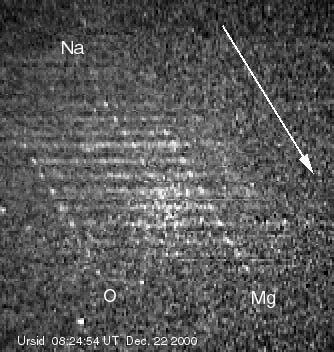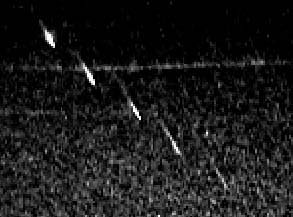|
Leonid MAC |
| home |
| View the shower |
| Mission Brief |
| Science Update |
| Media Brief |
| links |
LEONID DAILY NEWS: December 24, 2000
Observations of the December 22 Ursid outburst show that the relatively fresh ejecta of comet 8P/Tuttle bear much resemblance in morphology to the similarly fresh Leonid storm dust of comet 55P/Tempel-Tuttle. Both fall appart in many fragments after entering the Earth's atmosphere. During the 1998 Leonid Multi-Instrument Aircraft Campaign, Jiri Borovicka and co-workers of Ondrejov Observatory discovered an unusual feature in the optical spectra of Leonid outburst meteors [1]. Early in their trajectory, the meteors would emit mainly sodium atom (Na) emission, while later on the sodium disappeared and magnesium (Mg) was the dominantly emitting meteoric metal compound. Now, Peter Jenniskens of the SETI Institute, at NASA Ames Research Center, confirms that the same phenomenon is observed as well for the outburst Ursids. An Ursid spectrum obtained at 08:24:57 UT from a meteoroid belonging to dust ejected in 1405 or 1392, shows the early release of sodium that was so unusual for the Leonid meteors (see figure below). The meteor spectrum moved over the noisy central part of the intensifier, but the early onset of sodium (Na) and its absence at the final moments of the meteor are clearly detected. This unusual behaviour is attributed to fragmentation, as a result of which more volatile minerals in the grains are more efficiently exposed to the hot sputtering of the ablation vapor. The Ursids, too, are very fragile and fall appart in numerous fragments. This is also seen in the Ursid images. These meteoroids appear to fall appart at the end of their trajectory, forming a (still moving) elongated emission rather than the typical teardrop shape (see figure below). The spectrum also shows emission from the first positive band of molecular nitrogen, which implies that the air plasma temperature was not much different from that of the Leonids, despite the lower entry velocity (34 km/s, rather than 72 km/s) [2]. How much different that temperature still might be will be determined in further analysis. These and other results will be discussed in a future (2001) issue of Meteoritics & Plan. Science. 
Left: Composite of Ursid spectra covering the wavelength range from about 400 (right)
to 850 nm (left). Wavelength dispersion is horizontal in this image, with the meteor moving
in the direction of the arrow. Successive images show the changing spectrum over time, while
the meteor penetrates deeper into the Earth's atmosphere.This record was obtained with
an 230 l/mm grating, F0.7/135mm optics, and Gen II XX1332 Mullard intensified
slit-less spectrometer "Betsy" and recorded
on Hi-8.
The instrument was pointed at about 60 degrees elevation in western direction
from a site near Parkfield, California (Courtesy: Peter Jenniskens).
| ||
| Results of this work were published in Icarus. |


